-
 Bitcoin
Bitcoin $115500
-1.78% -
 Ethereum
Ethereum $3642
2.83% -
 XRP
XRP $3.083
1.94% -
 Tether USDt
Tether USDt $1.000
-0.04% -
 BNB
BNB $762.7
2.02% -
 Solana
Solana $178.6
-1.50% -
 USDC
USDC $0.9999
-0.02% -
 Dogecoin
Dogecoin $0.2277
0.97% -
 TRON
TRON $0.3155
4.59% -
 Cardano
Cardano $0.7993
3.56% -
 Hyperliquid
Hyperliquid $42.47
1.55% -
 Stellar
Stellar $0.4169
2.55% -
 Sui
Sui $3.658
3.17% -
 Chainlink
Chainlink $17.56
1.21% -
 Bitcoin Cash
Bitcoin Cash $524.9
6.28% -
 Hedera
Hedera $0.2374
1.76% -
 Avalanche
Avalanche $23.19
1.45% -
 Litecoin
Litecoin $111.6
3.65% -
 UNUS SED LEO
UNUS SED LEO $8.966
-0.29% -
 Shiba Inu
Shiba Inu $0.00001337
1.95% -
 Toncoin
Toncoin $3.107
1.90% -
 Ethena USDe
Ethena USDe $1.001
-0.03% -
 Uniswap
Uniswap $10.05
2.93% -
 Polkadot
Polkadot $3.943
0.17% -
 Monero
Monero $327.4
5.22% -
 Dai
Dai $1.000
0.01% -
 Bitget Token
Bitget Token $4.429
-2.68% -
 Pepe
Pepe $0.00001207
0.46% -
 Aave
Aave $287.1
2.95% -
 Cronos
Cronos $0.1285
8.11%
How to capture the starting point of contract by K-line pattern and volume?
A bullish engulfing pattern with high volume near support signals a strong long entry opportunity in crypto trading.
Jun 18, 2025 at 06:07 pm

Understanding the Basics of K-Line Patterns
K-line patterns are essential tools for technical analysis in the cryptocurrency market. These patterns, derived from Japanese candlestick charts, provide insights into potential price movements based on historical data. Each K-line represents a specific time period and displays the open, high, low, and close prices. By analyzing these patterns, traders can identify possible trend reversals or continuations. Bullish engulfing, bearish engulfing, hammer, and shooting star are some of the most commonly observed K-line formations that signal changes in market sentiment.
The Role of Volume in Confirming K-Line Signals
Volume plays a critical role in validating the signals generated by K-line patterns. A strong K-line formation without corresponding volume may not be reliable. For instance, if a bullish engulfing pattern appears but is accompanied by low trading volume, it might indicate weak buying pressure. Conversely, when such a pattern coincides with a surge in volume, it reinforces the likelihood of a genuine reversal. High volume during a K-line pattern suggests stronger participation from market players, which increases the probability of the anticipated move occurring.
Identifying Contract Entry Points Using K-Line and Volume Confluence
To capture the starting point of a contract position using K-line patterns and volume, traders should look for confluence between these two indicators. This means identifying moments where a significant K-line pattern forms alongside a noticeable increase in trading volume. One effective approach is to monitor key support and resistance levels where such confluence frequently occurs. When a hammer pattern forms near a strong support level and is supported by above-average volume, it may signal an ideal long entry opportunity. Similarly, a bearish engulfing pattern at a resistance zone with rising volume could present a short-selling opportunity.
Step-by-Step Guide to Analyzing K-Line and Volume for Contracts
- Begin by selecting a suitable time frame for your trade—day traders often use 15-minute or 1-hour charts, while swing traders may opt for daily or weekly charts.
- Identify recent K-line patterns that suggest a potential reversal or continuation.
- Overlay volume indicators on the chart to check whether the pattern is supported by increased trading activity.
- Use additional tools like moving averages or RSI to filter out false signals and confirm the strength of the identified pattern.
- Set entry points slightly above or below the K-line depending on the direction of the expected move, ensuring that stop-loss orders are placed appropriately to manage risk.
- Monitor the trade closely after entry and adjust positions if new K-line signals or volume spikes emerge.
Common Mistakes to Avoid When Combining K-Line and Volume Analysis
Many traders make the mistake of relying solely on K-line patterns without considering volume confirmation. A visually appealing pattern may appear promising, but without volume support, it’s often misleading. Another common error is over-analyzing multiple time frames, which can lead to conflicting signals. It's crucial to maintain consistency in the time frame being analyzed and avoid jumping between different views too frequently. Additionally, failing to apply proper risk management techniques, such as setting stop-losses and take-profit levels, can result in significant losses even when the initial analysis was correct.
Frequently Asked Questions
Q: Can I rely only on K-line patterns without checking volume?
A: While K-line patterns offer valuable insights, they should never be used in isolation. Volume acts as a confirmation tool that enhances the reliability of any pattern you observe. Ignoring volume may lead to entering trades based on false signals.
Q: What type of volume indicator should I use alongside K-line analysis?
A: Most traders prefer using the standard volume bar chart or On-Balance Volume (OBV) to complement their K-line observations. OBV helps track cumulative buying and selling pressure, making it easier to spot divergences that may precede trend changes.
Q: How do I determine if volume is significantly high or just average?
A: You can compare the current volume to the 20-period moving average of volume. If the current bar exceeds this average by a noticeable margin, it indicates strong participation. Spikes in volume relative to recent history often signify important market decisions.
Q: Are certain K-line patterns more effective than others when combined with volume?
A: Yes, some patterns tend to yield better results when validated by volume. Engulfing patterns, especially those forming at key levels, work well with volume confirmation. Doji and spinning tops also gain significance when appearing with abnormal volume, as they suggest indecision followed by a potential breakout.
Disclaimer:info@kdj.com
The information provided is not trading advice. kdj.com does not assume any responsibility for any investments made based on the information provided in this article. Cryptocurrencies are highly volatile and it is highly recommended that you invest with caution after thorough research!
If you believe that the content used on this website infringes your copyright, please contact us immediately (info@kdj.com) and we will delete it promptly.
- Bitcoin, Galaxy Digital, and Market Speculation: Decoding the Crypto Tea Leaves
- 2025-07-25 14:30:12
- Bitcoin ETFs: Fidelity, VanEck, and the Inflow Tidal Wave
- 2025-07-25 14:30:12
- XRP, Ripple, and Crypto: Riding the Wave in the Digital Asset Sea
- 2025-07-25 13:10:12
- Bitcoin, Crypto, and Ethereum: Navigating the New York Minute Market
- 2025-07-25 13:30:12
- SYRUP Listing, DeFi Lending, and Institutional Adoption: A New Era?
- 2025-07-25 13:30:12
- Binance Coin (BNB) Technical Breakout: Eyes on $1,200 Target
- 2025-07-25 13:35:12
Related knowledge

Is the divergence between MFI fund flow and price trend credible?
Jul 25,2025 at 12:01pm
Understanding MFI and Fund Flow in Cryptocurrency MarketsThe Money Flow Index (MFI) is a technical oscillator that combines price and volume to assess...

Should I go all-in when the ASI indicator breaks through?
Jul 25,2025 at 01:56pm
Understanding the ASI Indicator and Its SignificanceThe Accumulation Swing Index (ASI) is a technical analysis tool developed by Welles Wilder, the sa...

Should I go all in when DIF crosses DEA?
Jul 25,2025 at 12:42am
Understanding DIF and DEA in MACD AnalysisWhen traders analyze DIF and DEA in the context of the Moving Average Convergence Divergence (MACD) indicato...

Should I go all in when the upper edge of the box is broken?
Jul 25,2025 at 01:50am
Understanding the 'Box' in Cryptocurrency Price ChartsThe term 'box' in cryptocurrency trading typically refers to a price consolidation range where t...

Should I go all in when the parabolic turning signal appears?
Jul 25,2025 at 06:36am
Understanding the Parabolic Turning Signal in Crypto TradingThe parabolic turning signal is a technical indicator derived from the Parabolic SAR (Stop...

Should I follow up with a full position when the trading volume suddenly increases?
Jul 25,2025 at 12:28am
Understanding Sudden Increases in Trading VolumeA sudden spike in trading volume often signals heightened market activity and can indicate that new in...

Is the divergence between MFI fund flow and price trend credible?
Jul 25,2025 at 12:01pm
Understanding MFI and Fund Flow in Cryptocurrency MarketsThe Money Flow Index (MFI) is a technical oscillator that combines price and volume to assess...

Should I go all-in when the ASI indicator breaks through?
Jul 25,2025 at 01:56pm
Understanding the ASI Indicator and Its SignificanceThe Accumulation Swing Index (ASI) is a technical analysis tool developed by Welles Wilder, the sa...

Should I go all in when DIF crosses DEA?
Jul 25,2025 at 12:42am
Understanding DIF and DEA in MACD AnalysisWhen traders analyze DIF and DEA in the context of the Moving Average Convergence Divergence (MACD) indicato...

Should I go all in when the upper edge of the box is broken?
Jul 25,2025 at 01:50am
Understanding the 'Box' in Cryptocurrency Price ChartsThe term 'box' in cryptocurrency trading typically refers to a price consolidation range where t...

Should I go all in when the parabolic turning signal appears?
Jul 25,2025 at 06:36am
Understanding the Parabolic Turning Signal in Crypto TradingThe parabolic turning signal is a technical indicator derived from the Parabolic SAR (Stop...

Should I follow up with a full position when the trading volume suddenly increases?
Jul 25,2025 at 12:28am
Understanding Sudden Increases in Trading VolumeA sudden spike in trading volume often signals heightened market activity and can indicate that new in...
See all articles

























































































